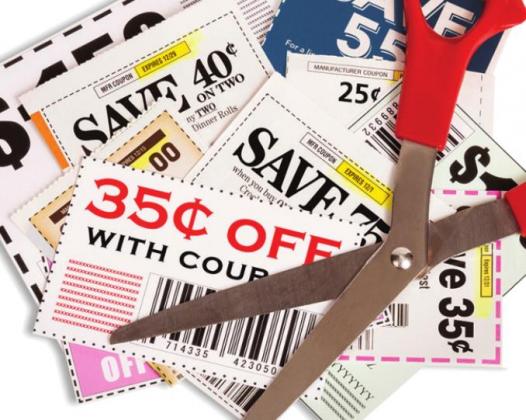SITTING HERE LOOKING AT a box of doughnuts a coworker brought in, I’m considering writing about temptation, moderation, and willpower. At the same time, I’m contemplating what to make for dinner for my college kids home for spring break. However, the thought of grocery shopping now fills me with fear and loathing. Never do I spend under $200 at the grocery store anymore, and unfortunately paychecks have not gone up to compensate for this inflation. I even find myself perusing the food ads in the Sunday paper instead of tossing them aside like usual. This new behavior has me fearing that I’m becoming like my mother—making grocery lists based on sales ads.
Obviously, eating healthy is key at every age, and it’s especially important for kids to be brought up eating healthy as eating patterns develop at a very young age. As regular readers know, I’m always recommending a variety of fruits, vegetables, grains, and protein foods, dairy, and/or fortified soy alternatives. Also, when choosing food, it’s important to look for options loaded with nutrients and limited in added sugars, saturated fats, and sodium.
But what about those skyrocketing food prices? Can you still eat well on a budget? Yes, you can! Here are some suggestions to help you cut costs while maintaining healthy eating habits:
Plan, plan, plan
Plan your meals for the week based on your budget, and make a grocery list that includes the basics and the perishables. I usually ask the family if anyone has any suggestions, and I often peruse EatingWell Magazine online (eatingwell.com) to get ideas. I’m a very visual cook, so if I see a picture of a meal and it looks good, I’m more apt to make it. I make a little pile of ideas on my kitchen table.
Plan for two to three nights of cooked meals, then a leftover recycle night. If you always have, say, pizza or fish on Fridays, then plan and budget for that. Buy only what you need.
Eat out less
My restaurant-owner friends will not like this suggestion, but let’s face it, with the pandemic, staffing shortages, and food shortages, the quality of restaurant dining has just not been the same as of late. Not to mention, I find that I can usually cook better, healthier, and equally tasty meals right at home.
Then again, for this suggestion to work, you have to really like cooking and being in the kitchen as I do. Having nice knives, cutting boards, and cookware is a huge help in the kitchen and worth the investment. You can find nice kitchen accessories for less at many stores.
Compare costs
I just started really doing this. Locate the unit price on the shelf sticker near the item price, and compare different brands and sizes for the best money-saving option. You may be accustomed to just grabbing the spaghetti sauce you like, but now you may really want to watch the price and compare. Also, be sure to watch those food labels if you’re looking for lower-sodium items or want to avoid saturated fats.
Stretch your food dollar
With meat prices escalating beyond belief, it’s imperative to stretch your protein and manage protein portion sizes. Fill up on salad and vegetables and choose fruit for dessert instead of grabbing another meat portion. Using beans and canned or frozen vegetables to bulk up your meals will also stretch your food dollar further. Not only will beans and vegetables make you feel full, but they’re also great sources of fiber, vitamins, and nutrients. Planning “Meatless Mondays” is another excellent way to help cut food costs, and there are lots of delicious meatless recipes out there to choose from.
Grow your own
Just yesterday, the whole office was sharing their garden plans, and many have started their seeds already. If you’d like to give gardening a try, find a nice sunny spot in your yard and plant three to four vegetables. Don’t overdo it with the number of plants, or you’ll end up with more produce than you can possibly feed to your family or give away to neighbors.
I like to plant a “salsa garden” with tomatoes, green peppers, and jalapeno peppers. Everything tastes so good and fresh! To spice up your cooking a bit, you might also want to plant herbs like basil, oregano, cilantro, thyme, chives, and dill. If you don’t have a lot of space in your garden, they’ll grow just as well in pots or in an herb box.
Buy in bulk
Do you hear Costco calling your name? I certainly do! You can often save money by buying food in larger quantities. Buy what’s on sale and what can last longer, such as grains, canned or dried beans, and frozen vegetables.
Shop the ads
Okay, I admit it, there’s no shame in shopping like Mom! Check those store flyers for items on sale. It’s a great way to save money while getting a variety of foods. Always look for sale items on the shelves, too. There may be five different brands of the same food item. Look for the one that’s on sale, even if it’s not the specific type or brand you usually choose. For example, Honey Crisp apples taste great, but there may be other delicious apples for much less right next to them.
As we all feel the pinch at the stores and gas pumps, it’s time to take a serious look at spending and find ways to make each dollar go further. But we can spend smarter without ignoring healthy foods and skimping on nutrition. It’s important not to lose sight of this because we don’t know if or when food prices will come back down again and the benefits of eating healthy add up over time. Hopefully these tips will help you maximize your food budget while minimizing your pain in the checkout line.
Laurie Syring, RD/LD, is Clinical Nutrition Manager at ProMedica Flower Hospital. ✲



